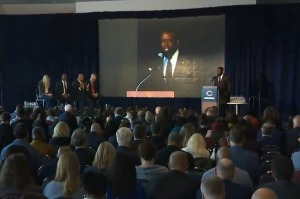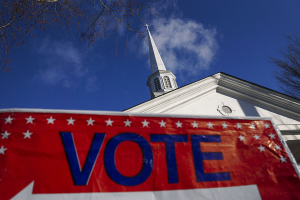The Last Church Standing in North Cyprus
How the Christian History was Erased
One lone church struggles to survive in a land where hundreds have been damaged or destroyed. But this is no ordinary land; it is the very area where Apostle Paul took his first missionary journey to proclaim salvation through Jesus Christ to the Roman Empire.
Now, 2,000 years later, the small Mediterranean island of Cyprus is divided into two, with the northern third occupied by Turkey. In the span of three decades under Turkish control, more than 530 churches and monasteries have been pillaged, vandalized, or destroyed in the northern area, according to The Republic of Cyprus.
"I cannot say that it (the destruction of churches) is encouraged openly by the Turkish government," said Cyprus's Ambassador to the United States, Andreas Kakouris, to The Christian Post. "All I can say is that it is taking place in the area that is under direct control of the Turkish military and I leave you to make your own conclusions from that."
Since its 1974 invasion, Turkey has controlled northern Cyprus, which it calls the "Turkish Republic of Northern Cyprus." No international nation has ever recognized this entity except for Turkey. The United States has only recognized the Republic of Cyprus.
Starting in 2003, Greek-Cypriots again were allowed to cross the border between the Republic of Cyprus and the area under Turkish control. It was around this time that scholars and photographers were able to visit northern Cyprus to document the destruction of historic churches and artifacts.
St. Mamas Church in the northwest town of Morphou is the only notable church that is known to be semi-active in Turkey-controlled Cyprus, according to the New York-based Hellenic Times and the Embassy of The Republic of Cyprus in the United States. Turkish officials who rule the area reportedly give permission twice a year for remaining residents – who were there before Turkish occupation – to worship in the church.
Other churches were not so fortunate.
About 133 churches, chapels and monasteries have been converted to military storage facilities, stables and night-clubs. Seventy-eight churches have been converted to mosques, and dozens more are used as military facilities, medical storage facilities, or stockyards or hay barns, according to statistics from The Republic of Cyprus.
Agia Anastasia Church in Lapithos was converted into a hotel and casino, while the Sourp Magar Armenian monastery – founded in the medieval period – was converted into a cafeteria.
A Neolithic settlement at the Cape of Apostolos Andreas-Kastros in the occupied area of Rizokapraso – a site declared an ancient monument by the Republic of Cyprus – was bulldozed by the Turkish Army in order to plant two of its flagpoles on top of the historic hill.
While Muslims make up more than 99 percent of Turkey's population, according to the CIA World Factbook, Ambassador Kakouris says it's "not a Muslim-Christian issue."
"I don't think the Cyprus problem has ever been a religious issue between the Greek and Turkish Cypriots," said Kakouris, who is a Greek Orthodox Christian.
But he added that even though Turkey's constitutionally secular government may not have given the "green light" for the destruction of churches and artifacts, they have not given the "red light" either.
"So it is … either directly taking place or with their blind eye or whatever you want to call it. But they are responsible for what is taking place there," Kakouris said.
Furthermore, over 15,000 portable religious icons were stolen and auctioned off around the world.
Relics – which include fine icons, mosaics and frescoes from ancient Byzantine era – have turned up at auction houses around the world, including at the prestigious Sotheby's in New York.
In January 2007, six icons were returned to the Church of Cyprus after being smuggled out of the country. They were to be put up for auction at Sotheby's.
Also, back in 1988, four pieces of an invaluable work of art dating between 525 and 530 A.D. were recovered when a Turkish art dealer offered to sell it to an American antique dealer for $1 million. The American dealer contacted the Paul Getty Museum in Malibu to resell the mosaics for $20 million. The museum then informed the Cypriot Church about the art work.
In the end, U.S. courts ruled that the Cypriot Church was the legitimate owner of the pieces, and they are now shown in the Byzantine Museum of Nicosia.
It is estimated that more than 60,000 ancient artifacts have been illegally transferred to other countries, according to the Republic of Cyprus. Sadly, most of these artifacts were not recovered.
Cyprus has some of the finest collections of Byzantine art in the world, offering scholars and others the priceless study on the development of Byzantine wall-painting art from the 8th-9th century until the 18th century A.D.
The United States has recognized Cyprus' endangered cultural heritage, and in 1999 and 2003 the U.S. Treasury Department issued emergency import restrictions on Byzantine Ecclesiastical and Ritual Ethnological Materials from Cyprus.
Then, in 2002, the United States and Cyprus signed a Memorandum of Understanding (MOU) concerning the import restrictions on pre-classical and classical archeological objects from Cyprus. The MOU was amended and renewed in 2006 and 2007 to include additional artifacts.
Kakouris says that the Cyprus issue has been ignored for decades by the international community.
"There is only so much oxygen that exists from a journalistic point of view," he noted. "When one picks up the paper and looks at international issues what does one see? Either a bombing that took place in the Middle East or a bombing in Iraq or loss of life in Afghanistan – issues such as that."
"Although there are issues that appear to be more important than the Cyprus issue – because we don't have that immediacy of seeing deaths or events on a daily basis in Cyprus, thankfully – that does not make the continuing occupation by Turkey of the northern part of Cyprus any more acceptable," the ambassador added.
There were 20,000 Greek Cypriots in the Turkish-controlled area after 1974, but today there are about 450 Greek Cypriots remaining. Over 80 percent of the Republic of Cyprus population is Christian.
While the island population is only 800,000, it is a major tourist attraction, drawing over 2 million tourists each year.




























